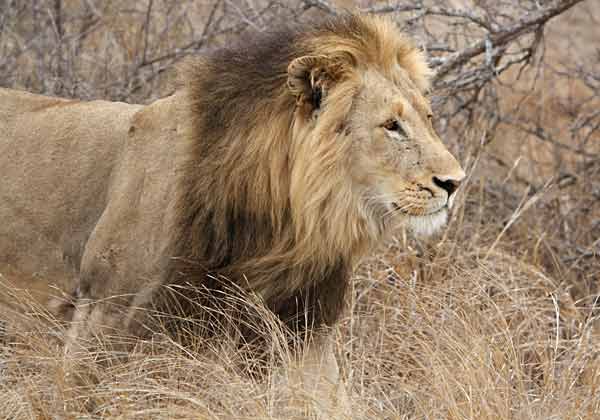
| ||||||||||
|
||||||||||
Lion Notes 5Welcome to page 5 of pictures and notes in brief about lions, lion sightings and lion behaviour based on visits and photo safaris to southern and East African game reserves and national parks. All images © Scotch Macaskill - for more, see Terms of Use.Young Lions Raise Heads in Alarm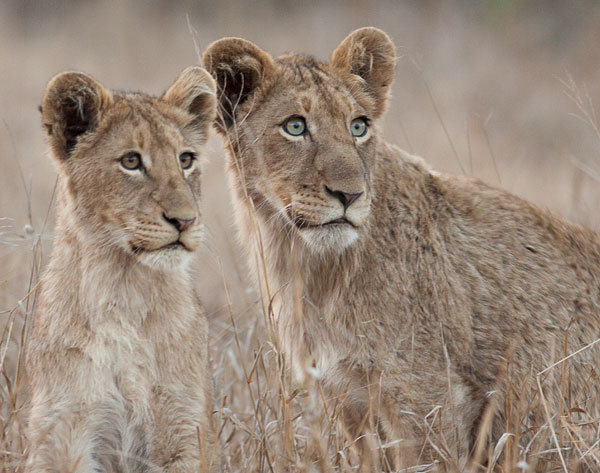
Photo Details: Two young lions raise their heads in alarm from the safe haven of long winter grass, Kruger National Park, South Africa. Camera: Canon EOS 50D; Lens: Canon EF 400mm f/5.6L USM; Aperture: f/5.6; Shutter speed: 1/60; ISO: 400; Additional Info: These two lion cubs - from different litters as the one is clearly older - were part of a pride of about eight lions lying in tall winter grass close to the road near Satara Camp in the Kruger Park. It was already late afternoon and also the final day of July school holidays. Lion sightings had been sparse in the area, so for many this was the last opportunity to see the big cats before returning home. Drivers jostled for position, blocking the road and creating a mini gridlock. The lions were fairly oblivious of all this, occasionally lifting their heads or changing positions. In the meantime it was getting close to 5.30pm, which is camp closing time in winter. But the road was jammed. Tempers flared and people started hooting and shouting. Eventually some frustrated person played a tape of lions roaring through his car speakers, probably hoping to get the animals to move so everyone could disperse. It was this sound, rather than the hooting, that caused the young lions to raise their heads and look around in consternation. Eventually the fear of being locked out of camp and paying hefty fines saw the traffic jam break up, leaving the lion pride in peace, free from the stares and cameras of badly behaved humans. Lion Male, Close-up of Head and Shoulders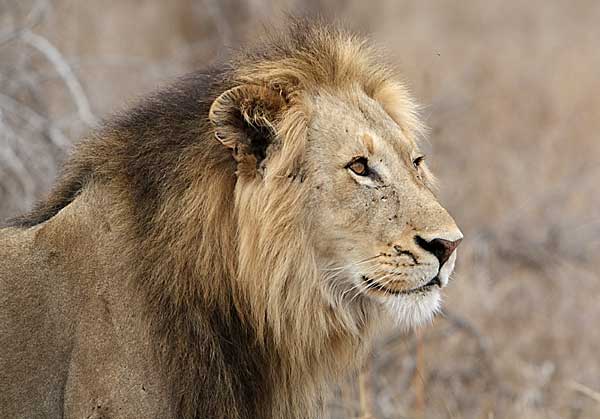
Photo Details: Male lion (Panthera leo) staring into the distance after he and another male had put a small herd of buffalo to flight, Kruger National park, South Africa. Camera: Canon EOS 450D (Canon Rebel XSi 12.2MP); Lens: Canon 70-200 F2.8L IS USM; Focal Length: 200mm; Shutter speed: 1/1000; Aperture: f/4; ISO: 200. Additional Info: The above image was taken as the lion paused on the side of the road, close to our vehicle, allowing me to take a portrait-type picture. The aperture of f/4 at full zoom (200mm) is sufficiently wide to throw the background out of focus, allowing the main subject to stand out. A few moments before, I took the picture below, also at full zoom and at f/4. Because the lion is further away, more of the subject is included in the frame, giving a three-quarter or head and torso view. Depth of field has also now increased, with more background detail visible. Although the extra detail that results from more depth of field can be distracting, in this case it serves to show the subject in its location — the African bush, and definitely not a European or American zoo. Having said that, I still prefer the close-up with blurred background.
Cute Lion Cubs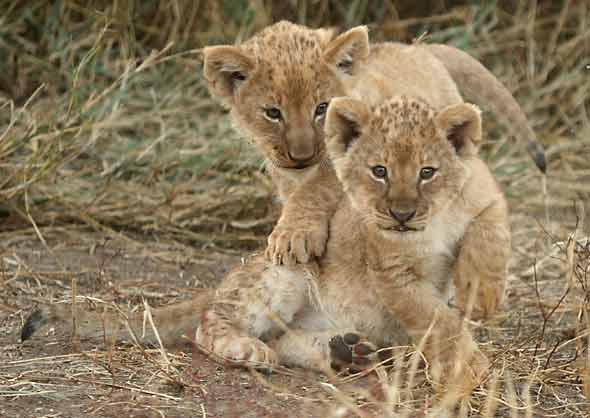
Photo Details: Lion cubs (Panthera leo) take time out after wrestling and rolling around in the grass, Mashatu Game Reserve, Tuli Block, Botswana. Camera: Canon EOS 400D (Canon Rebel XS 10.1MP); Lens: Canon EOS 80-200 F2.8 zoom; Focal Length: 200mm; Shutter speed: 1/250; Aperture: f2.8; ISO: 400 Additional Info: At this age, around four to six weeks old, lion cubs are very like domestic kittens – cuddly, playful bundles of fur. But the size of the paws is a dead giveaway, a sobering reminder of how big, dangerous and distinctly uncuddly these cats will eventually be. Lioness with Playful Lion Cub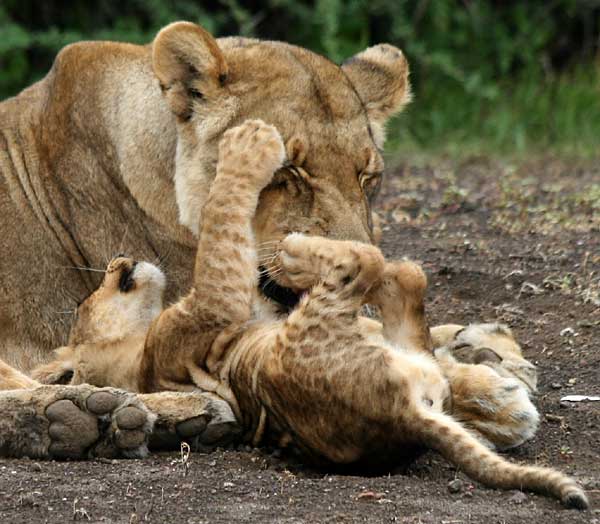
Photo Details: Lion cub, eager to play, paws and prods dozing lioness, Mashatu Game Reserve, Tuli Block, Botswana. Camera: Canon EOS 400D (EOS Digital Rebel XTi); Lens: Canon EF 70-300mm f/4.5-5.6 IS USM Telephoto Zoom; Focal Length: 210mm; Aperture: F5.6; Shutter Speed: 1/500; ISO: 400 Additional Info: The lioness above, in a show of maternal tolerance, was unfazed by the playful cub clambering over her and pawing her in the face. Although we assumed this was a mother and her cub, it’s possible that the cub wasn’t hers, as females within the same pride will often have cubs at more or less the same time. This allows some females to go out hunting while other mothers care for the babies. Cubs have the best chance of survival when a number of litters are born almost simutaneously as such cubs can be cared for communally. When it’s time to give birth, a lioness leaves the pride and has her cubs in thick cover where she keeps them hidden until she introduces them to the rest of the pride when they’re about two months old. From this point it’s possible they can be suckled by any lactating females (called allo-suckling) as pride females suckle one another’s cubs with no bias towards their own. Thus one lioness may be seen suckling cubs of differents sizes and ages. For more information about baby lions and their relationship with other members of the pride, see our gallery of Baby Lion Pictures. Jump to Lion Notes 6 or return to Wildlife Notes Home |
SEE ALSO:
|
|||||||||
|
Contact Details: Scotch Macaskill, Dirt Road Traders, Currys Post Road, Howick, KwaZulu-Natal, South Africa. Tel: +27 (0)82 578 2329. Privacy: Your privacy is guaranteed. See our Privacy Policy for more. This site accepts advertising and other forms of compensation - see Disclosure and Advertising for details. Site updated: 2022. Copyright © 2002 - 2022 Scotch Macaskill | ||||||||||
